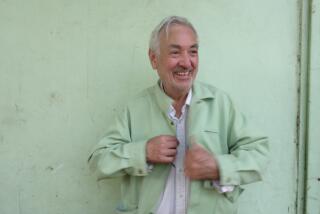Humanity Stressed in Creativity
- Share via
Believing that “designers should be equally prepared to create everything from a spoon to a city,” New York-based designer Massimo Vignelli recently set forth in Pasadena his philosophy on how to achieve this in our design schools.
As keynote speaker during the June 21 inauguration of David R. Brown as president of Art Center College of Design, Vignelli noted that education in the last 20 years “has mostly focused on technical skills relating to commercial art. We are now living through an exciting moment of (design) transition, and we need to face the challenges coming in the next 20 years.
“We must put the accent on humanity. Students should understand the thought processes of previous designers, know more theory, and develop a sense of appropriateness in design. A basic discipline and attitude (toward problem solving) will serve all work, whether designing cars, brochures or interiors. By doing so, I predict that designers will be as equally prepared as other design-related professionals.”
Vignelli expressed both surprise and dismay “that in a world where absolutely everything around us is designed, the designers don’t get much respect. We need to have more pride in our profession, enough to resist marketers efforts to change what we know is right!”
Delving into his own artistic Italian background, Vignelli favors “developing a sense of ambiguity in design, in which one could ‘read’ different meanings. . . . This plurality of meaning doesn’t exist in this country.
“Milan has more designers per square foot than anywhere else, but very few good schools of design. That is not true here, but the task is to mix international ideas, to expand our boundaries.”
Vignelli and his wife Lella, who is also trained as an architect, formed their own design firm in 1965 after moving from Milan. Multi-disciplinary in their own work, they have designed corporate identity and graphic programs, transportation and architectural graphics, exhibitions, interiors, furniture and a variety of products.
Vignelli is also a member of Art Center’s board of advisers. Two Los Angeles design teams received honorable mentions in Philadelphia’s recent “City Visions” international competition, conceived and conducted by the Foundation for Architecture in Philadelphia, and sponsored by CertainTeed Corp.
Those honored from Los Angeles were Paul Allan Murdoch, and a team led by Ted L. Tanner and J. Alison Wright, with Dana Montgomery and Joan Tanner.
The competition generated conceptual design schemes from 211 entrants, from 22 states in the United States and three foreign countries. While submissions addressed relevant issues for Philadelphia’s neighborhoods, downtown or region, the organizers also hoped that the influx of ideas could be translatable to other cities with the same problems.
It is quite appropriate that Philadelphia launch such a major urban design competition, for it has been an acknowledged leader in city planning, from its original plans of William Penn through the tenure of Edmond Bacon as executive director of the city Planning Commission. His famous city plan, implemented during the 1950s and 60s, sparked development unparalled in Philadelphia’s history.
Murdoch’s submission reinforced the center city’s connection to its neighborhoods, focusing on the transformation of major streets into a series of plazas and parks alternating with high-density development. The jury particularly liked one facet in which a major expressway was depressed, and topped with a grassy park containing with pools and fountains.
The Tanner team proposed the conversion of the historic former Eastern State Penitentiary into a 200-room luxury hotel. The jurors were enthusiastic about this adaptive reuse, and favorably responded to the design’s “surreal charm, inspired by the remodeled paradors of Spain.”
The seven-member jury also had Los Angeles representation, with Charles Moore, architect and UCLA professor, and Paul Prejza, whose firm of Sussman/Prejza & Co. co-developed the design for the 1984 Olympic Games.
The five winners, each awarded $10,000 from CertainTeed, were all from the East: Patrice Louise Lynch and Brian James Wait, Philadelphia; Patricia Kucker and Wesley Wei, Philadelphia; Louise Schiller, Princeton, N. J.; Ian Michael Cope, Philadelphia; and Stephen Matthew Heinz, Yardley, Pa.
Sam Hall Kaplan is traveling in Europe on a National Endownment of the Arts grant.
More to Read
The biggest entertainment stories
Get our big stories about Hollywood, film, television, music, arts, culture and more right in your inbox as soon as they publish.
You may occasionally receive promotional content from the Los Angeles Times.










